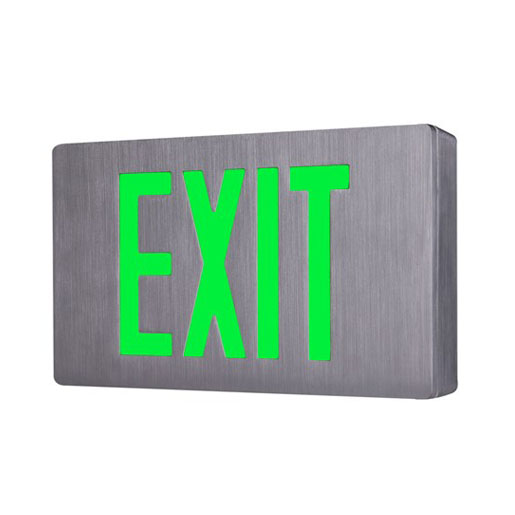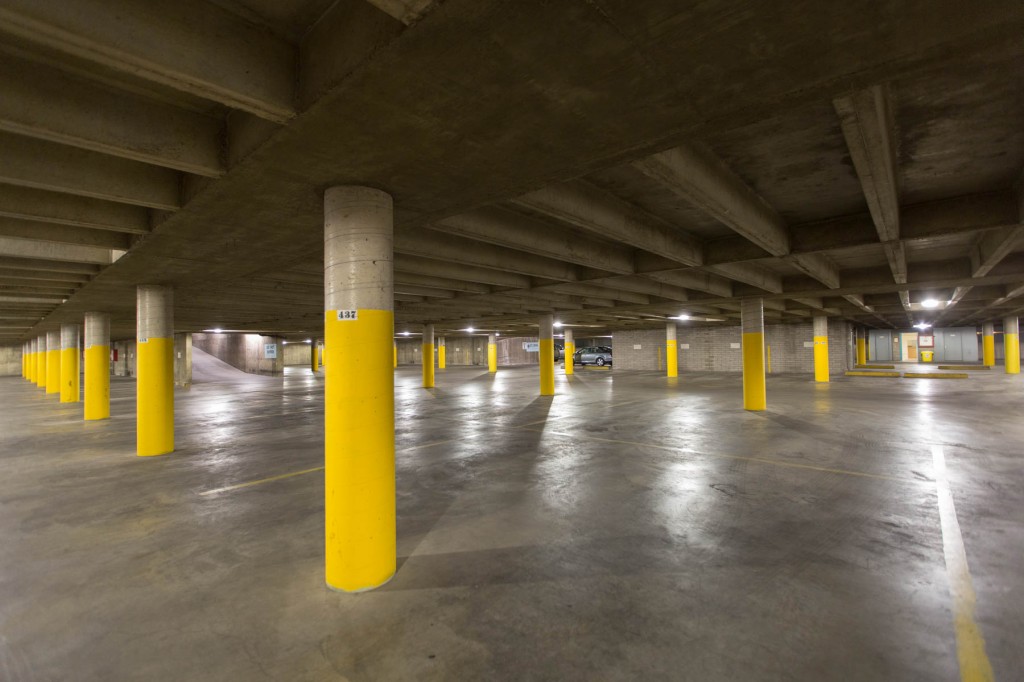 hybrid: www.isolite.com
hybrid: www.isolite.com
Dual Technology Exit Signs:
Increased Reliability, Whether Power is On or Off
By combining two established technologies – LED and photoluminescence – in one unit, exit signs deliver reliable, maintenance-free operation for decades
For building and facility owners or managers striving to meet fire and safety codes, new “dual technology” exit signs are combining the efficiency of LED lighting with revolutionary new photoluminescent materials to increase reliability and performance over decades of use.
This hybrid approach combines two established exit sign technologies in a single unit – LED and photoluminescence. During normal power conditions, the sign is illuminated with highly efficient LEDs. When the power goes out, a translucent exit stencil diffusor made of photoluminescent material provides the illumination. This is charged by the LEDs while electric power is provided to the sign.
Egress marking requirements often dictate the installation of exit signs in locations of low light conditions. This problem, coupled with energy conservation strategies such as occupancy sensors, can make it impossible to use photoluminescent signs and achieve code compliance. Recognizing this problem, leading emergency lighting manufacturers now offer advanced, dual technology options that utilize internal LEDs to “charge” the photoluminescent material, rather than relying on an external charging source.
This ensures the exit sign will be visible, no matter the power conditions. The increased reliability of this dual technology also has a significant side benefit – it eliminates the need for battery backup, reducing some of the costs related to testing, maintaining or replacing exit signs over time.
“The dual technology approach eliminates the need for backup power for the exit sign, whether through an internal battery or an external inverter or generator,” says Bill Lynch, president of Isolite, a manufacturer of specification-grade emergency lighting products. “This significantly increases reliability, simplifies maintenance and reduces total costs.”
The Battery Problem
Traditionally, exit signs include internal batteries to power the sign in case of power outage, yet batteries remain the single highest potential point of failure in these systems. Batteries typically have a lifespan of 5-7 years before they must be replaced; less if damaged by corrosion, overheating, and other issues.
Because it is a safety issue, exit signs must meet a number of standards from regulatory agencies. This includes, most notably, the NFPA 101 Life Safety Code (which requires a reliable source of light and at least 90 minutes of emergency light if the building’s power goes out) and UL 924, UL’s Standard for Safety of Emergency Lighting and Power Equipment.
To meet the requirements of these codes, exit signs with backup batteries much be tested every thirty days, a practice that typically involves sending a maintenance worker to climb a ladder and push a small button that confirms the batteries are still in good working order.
In reality, these guidelines are not always followed, so if the battery fails, it is often not known until an actual power outage. If the sign fails to illuminate fully, or at all, when it is most needed, it could constitute a major life safety issue and even potential liability.
Photoluminescent Signs
Standard photoluminescent exit signs have been in use for more than a decade. However, as a standalone technology, this technology has limitations.
For example, such signs require an activating light source to shine on them during all times of building occupancy. Often the available light is not sufficient to charge the photoluminescent material, particularly as energy efficient building standards such as California’s Title 24 lead to lights being dimmed or switched off more frequently when not in use.
When insufficient light is available, photoluminescent signs will fail to illuminate to the required standards and could pose a serious safety hazard
Better in Combination
The hybrid approach combines technologies to provide even more reliable illumination, whether the power is on or off. However, designing such units turned out to be far more complex than simply putting both in a single architectural fixture.
One system that takes this unique design approach is Isolite’s hybrid LED photoluminescent exit sign, the Dual Tech 2.0. The sign utilizes internal LEDs to charge the photoluminescent material to ensure it is visible at all times at a 100 foot viewing distance for a minimum of 90 minutes – the normal standard for electric signs.
Since there is no battery to check on a monthly basis, the unit costs less to maintain and is expected to perform for 20 or more years. The Dual Tech 2.0 comes with OSHA, NFPA 101 Life Safety Code, NFPA 70-NEC, and UL 924 approvals.
According to Lynch, special LEDs had to be manufactured to emit the specific wavelength of light required to optimally charge the photoluminescent material so that it would provide the proper illumination to meet code requirements.
Cost Savings
According to Lynch, there are other benefits to this hybrid approach as well, which costs only nominally more than the traditional LED signs.
Compared with typical battery reliant, LED exit signs that use about 4 watts of power, the hybrid unit uses about half the power, less than 2 watts. This is due to a unique electronic driver circuit that provides current control and protection, which helps to ensure optimum LED efficiency and life.
Eliminating a reliance on batteries is also good for the environment, since both the manufacture and disposal of batteries involves toxic chemicals.
“While LED technology has improved to the point where it can last over 20 years, battery technology has not kept pace and has been the weak point in exit sign reliability and maintenance,” concludes Lynch. “Hybrid LED/photoluminescent technology eliminates this weakness and provides a more reliable operation for decades.”
For more information, contact Isolite at 31 Waterloo Avenue, Berwyn, PA 19312; call 800-888-5483; or visit them on the web at www.isolite.com
By Del Williams
Del Williams is a technical writer based in Torrance, California.
_______________________________________________________________________
U-Haul saves millions of KWh energy usage
U-Haul recently retrofitted its Phoenix, Arizona parking structure with Cree LED lighting, and the results are being noticed! The lighting has improved visibility and reduced glare, creating a safe environment for customers and employees. Cree replaced nearly 400 fluorescent lighting fixtures with multiple products including the VG Series LED parking structure luminaires, helping U-Haul reduce wattage by 17,000 watts. This also translates to an expected 15 percent increase in energy savings and additional rebates. Other products used in the install included the LS Series, XSP Series, and the OSQ Area.
Opportunity
At the U-Haul corporate headquarters parking structure in Phoenix, Arizona, the existing lighting was inconsistent and not aesthetically pleasing. The lighting tended to yellow and could cast shadows that created a murky effect throughout the structure. The less than ideal lighting was also energy inefficient.
When U-Haul began its search for a new lighting solution, it turned to LED lighting. U-Haul had previously considered LED technology but was concerned about the high temperatures
in Phoenix so it initially considered fluorescent and induction options because of the higher Kelvin temperatures available. However, since its initial look, LED lighting technology greatly improved and became the clear choice for U-Haul this time around.
U-Haul Company’s requirements for its LED lighting solution included better light quality and performance, lower maintenance needs and costs, an outstanding product warranty and light-level control functionality. All of these features were needed without compromising on the ability to meet U-Haul Company’s prime sustainability goal of energy reduction. Cree® LED lighting was able to deliver the energy reduction U-Haul was seeking with all the performance, quality and control features it demanded.
Solution
The lighting upgrade for U-Haul was comprehensive and
provided an excellent opportunity to maximize energy savings. “The scope of the project included replacing nearly 400
fluorescent lighting fixtures with LED luminaires,” said Michelle Sullivan, U-Haul Manager of Corporate Sustainability. All of the
lighting in the parking garage was from 4-foot, 25-watt T8 lamps and roughly 85 percent of all fixtures included four lamps. “With the new LED applications we were able to eliminate more than 12 percent of our existing fixtures,” Sullivan continued.
The T8 lamps were replaced with Cree® VG Series LED parking structure luminaries because of the light quality and output and lighting controls available. The 24/7 availability of the corporate office meant the parking structure lighting would be on 24/7. With the VG Series lighting control features, the new lights operate when needed—and time in use has been trimmed to approximately four hours per day.
Along with energy saved via its new lighting solution, U-Haul saved maintenance costs as well. Prior to the new lighting, maintenance was performed by U-Haul building technicians approximately every three weeks and was scheduled before or after normal business hours for minimal impact on the normal traffic flow. Material costs, time and labor added up to a costly monthly exercise. Now, the building technicians can focus
on other areas of the facility as the costs of installation and replacement products are freed up for other expenses.
“One of the primary initiatives of U-Haul Corporate Sustainability is our commitment to energy-efficiency. Our Cree® lighting solution has absolutely supported our initiatives.” Michelle Sullivan, U-Haul Manager of Corporate Sustainability
In addition to positive numbers surrounding maintenance and energy savings, feedback on the new lighting has been excellent. “There are no longer dimly-lit areas in our parking structure that had previously raised safety concerns. With the increased amount and quality of light, visibility in the garage has improved overall,” Sullivan said.
Benefits
The U-Haul project included installation of 324 Cree® VG Series parking structure luminaries, more than 50 Cree® LS Series surface ambient luminaires for ramp and stairwell lighting and OSQ Series and XSP Series outdoor luminaires. U-Haul is very pleased with its lighting solution because Cree was able to accommodate the aged and uniquely-shaped parking structure. This allowed U-Haul to modernize its lighting while working within its longstanding building design.
“The response from our U-Haul Team Members regarding
the LED lights, including the amount and quality of light they provide, has been excellent,” Sullivan said. “The lighting has created a safer, sharper, more sustainable environment for our corporate parking structure.”
Along with vastly improved light quality, U-Haul is seeing its energy savings grow. The industry leader in do-it-yourself moving and self-storage expects to realize more than 15 percent energy savings from the LED lighting upgrade. The new lighting has reduced the existing wattage by more than 17,000 watts to provide an estimated annual kilowatt hour savings of more than 250,000 kWh. The expected lifetime savings is 3.7 million kWh. Additionally, U-Haul benefited from a generous rebate from Arizona Public Service (APS), its local utility provider.
